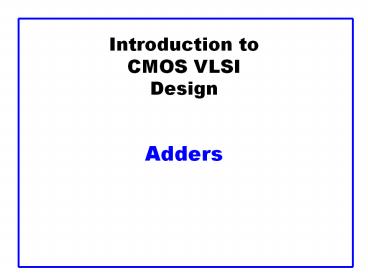Introduction%20to%20CMOS%20VLSI%20Design%20%20Adders - PowerPoint PPT Presentation
Title:
Introduction%20to%20CMOS%20VLSI%20Design%20%20Adders
Description:
For a full adder, define what happens to carries. Generate: Cout ... Knowles [2, 1, 1, 1] Adders. Slide 42. CMOS VLSI Design. Ladner-Fischer. Adders. Slide 43 ... – PowerPoint PPT presentation
Number of Views:174
Avg rating:3.0/5.0
Title: Introduction%20to%20CMOS%20VLSI%20Design%20%20Adders
1
Introduction toCMOS VLSIDesignAdders
2
Outline
- Single-bit Addition
- Carry-Ripple Adder
- Carry-Skip Adder
- Carry-Lookahead Adder
- Carry-Select Adder
- Carry-Increment Adder
- Tree Adder
3
Single-Bit Addition
- Half Adder Full Adder
A B Cout S
0 0
0 1
1 0
1 1
A B C Cout S
0 0 0
0 0 1
0 1 0
0 1 1
1 0 0
1 0 1
1 1 0
1 1 1
4
Single-Bit Addition
- Half Adder Full Adder
A B Cout S
0 0 0 0
0 1 0 1
1 0 0 1
1 1 1 0
A B C Cout S
0 0 0 0 0
0 0 1 0 1
0 1 0 0 1
0 1 1 1 0
1 0 0 0 1
1 0 1 1 0
1 1 0 1 0
1 1 1 1 1
5
PGK
- For a full adder, define what happens to carries
- Generate Cout 1 independent of C
- G
- Propagate Cout C
- P
- Kill Cout 0 independent of C
- K
6
PGK
- For a full adder, define what happens to carries
- Generate Cout 1 independent of C
- G A B
- Propagate Cout C
- P A ? B
- Kill Cout 0 independent of C
- K A B
7
Full Adder Design I
- Brute force implementation from eqns
8
Full Adder Design II
- Factor S in terms of Cout
- S ABC (A B C)(Cout)
- Critical path is usually C to Cout in ripple
adder
9
Layout
- Clever layout circumvents usual line of diffusion
- Use wide transistors on critical path
- Eliminate output inverters
10
Full Adder Design III
- Complementary Pass Transistor Logic (CPL)
- Slightly faster, but more area
11
Full Adder Design IV
- Dual-rail domino
- Very fast, but large and power hungry
- Used in very fast multipliers
12
Carry Propagate Adders
- N-bit adder called CPA
- Each sum bit depends on all previous carries
- How do we compute all these carries quickly?
13
Carry-Ripple Adder
- Simplest design cascade full adders
- Critical path goes from Cin to Cout
- Design full adder to have fast carry delay
14
Inversions
- Critical path passes through majority gate
- Built from minority inverter
- Eliminate inverter and use inverting full adder
15
Generate / Propagate
- Equations often factored into G and P
- Generate and propagate for groups spanning ij
- Base case
- Sum
16
Generate / Propagate
- Equations often factored into G and P
- Generate and propagate for groups spanning ij
- Base case
- Sum
17
PG Logic
18
Carry-Ripple Revisited
19
Carry-Ripple PG Diagram
20
Carry-Ripple PG Diagram
21
PG Diagram Notation
22
Carry-Skip Adder
- Carry-ripple is slow through all N stages
- Carry-skip allows carry to skip over groups of n
bits - Decision based on n-bit propagate signal
23
Carry-Skip PG Diagram
- For k n-bit groups (N nk)
24
Carry-Skip PG Diagram
- For k n-bit groups (N nk)
25
Variable Group Size
Delay grows as O(sqrt(N))
26
Carry-Lookahead Adder
- Carry-lookahead adder computes Gi0 for many bits
in parallel. - Uses higher-valency cells with more than two
inputs.
27
CLA PG Diagram
28
Higher-Valency Cells
29
Carry-Select Adder
- Trick for critical paths dependent on late input
X - Precompute two possible outputs for X 0, 1
- Select proper output when X arrives
- Carry-select adder precomputes n-bit sums
- For both possible carries into n-bit group
30
Carry-Increment Adder
- Factor initial PG and final XOR out of
carry-select
31
Carry-Increment Adder
- Factor initial PG and final XOR out of
carry-select
32
Variable Group Size
- Also buffer
- noncritical
- signals
33
Tree Adder
- If lookahead is good, lookahead across lookahead!
- Recursive lookahead gives O(log N) delay
- Many variations on tree adders
34
Brent-Kung
35
Sklansky
36
Kogge-Stone
37
Tree Adder Taxonomy
- Ideal N-bit tree adder would have
- L log N logic levels
- Fanout never exceeding 2
- No more than one wiring track between levels
- Describe adder with 3-D taxonomy (l, f, t)
- Logic levels L l
- Fanout 2f 1
- Wiring tracks 2t
- Known tree adders sit on plane defined by
- l f t L-1
38
Tree Adder Taxonomy
39
Tree Adder Taxonomy
40
Han-Carlson
41
Knowles 2, 1, 1, 1
42
Ladner-Fischer
43
Taxonomy Revisited
44
Summary
Adder architectures offer area / power / delay
tradeoffs. Choose the best one for your
application.
Architecture Classification Logic Levels Max Fanout Tracks Cells
Carry-Ripple N-1 1 1 N
Carry-Skip n4 N/4 5 2 1 1.25N
Carry-Inc. n4 N/4 2 4 1 2N
Brent-Kung (L-1, 0, 0) 2log2N 1 2 1 2N
Sklansky (0, L-1, 0) log2N N/2 1 1 0.5 Nlog2N
Kogge-Stone (0, 0, L-1) log2N 2 N/2 Nlog2N































